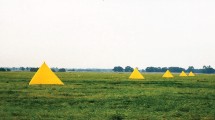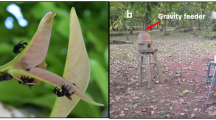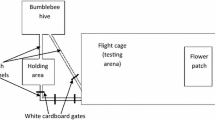Abstract
Learning and applying relational concepts to solve novel tasks is considered an indicator of cognitive-like ability. It requires the abstraction of relational concepts to different objects independent to the physical nature of the individual objects. Recent research has revealed the honeybee’s ability to rapidly learn and manipulate relations between visual stimuli such as ‘same/different’, ‘above/below’, or ‘larger/smaller’ despite having a miniature-sized brain. While honeybees can solve problems using rule-based relative size comparison, it remains unresolved as to whether bees can apply size rules when stimuli are encountered successively, which requires reliance on working memory for stimuli comparison. Additionally, the potential ability of bees to extrapolate acquired information to novel sizes beyond training sets remains to be investigated. We tested whether individual free-flying honeybees could learn ‘larger/smaller’ size rules when visual stimuli were presented successively, and whether such rules could then be extrapolated to novel stimulus sizes. Honeybees were individually trained to a set of four sizes such that individual elements might be correct, or incorrect, depending upon the alternative stimulus. In a learning test, bees preferred the correct size relation for their respective learning group. Bees were also able to successfully extrapolate the learnt relation during transfer tests by maintaining the correct size relationships when considering either two smaller, or two larger, novel stimulus sizes. This performance demonstrates that an insect operating in a complex environment has sufficient cognitive capacity to learn rules that can be abstracted to novel problems. We discuss the possible learning mechanisms which allow their success.




Similar content being viewed by others
References
Alfano PL, Michel GF (1990) Restricting the field of view: perceptual and performance effects. Percept Mot Skills 70:35–45
Andrew SC, Perry CJ, Barron AB, Berthon K, Peralta V, Cheng K (2014) Peak shift in honey bee olfactory learning. Anim Cogn 17:1177–1186
Ashman T-L, Stanton M (1991) Seasonal variation in pollination dynamics of sexually dimorphic Sidalcea oregana ssp. spicata (Malvaceae). Ecology 72:993–1003
Avarguès-Weber A, Giurfa M (2013) Conceptual learning by miniature brains. Proc R Soc of London B Biol Sci 280:20131907
Avarguès-Weber A, de Brito Sanchez MG, Giurfa M, Dyer AG (2010) Aversive reinforcement improves visual discrimination learning in free-flying honeybees. PLoS ONE 5:e15370–e15370
Avarguès-Weber A, Dyer AG, Giurfa M (2011) Conceptualization of above and below relationships by an insect. Proc R Soc of London B Biol Sci 278:898–905
Avarguès-Weber A, Dyer AG, Combe M, Giurfa M (2012) Simultaneous mastering of two abstract concepts by the miniature brain of bees. Proc Natl Acad Sci 109:7481–7486
Avarguès-Weber A, d’Amaro D, Metzler M, Dyer AG (2014) Conceptualization of relative size by honeybees. Front Behav Neurosci 8:1–8
Benitez-Vieyra S, Ordano M, Fornoni J, Boege K, Domínguez C (2010) Selection on signal–reward correlation: limits and opportunities to the evolution of deceit in Turnera ulmifolia L. J Evol Biol 23:2760–2767
Benitez-Vieyra S, Fornoni J, Pérez-Alquicira J, Boege K, Domínguez CA (2014) The evolution of signal–reward correlations in bee-and hummingbird-pollinated species of Salvia. Proc R Soc of London B Biol Sci 281:20132934
Beugnon G, Macquart D (2016) Sequential learning of relative size by the Neotropical ant Gigantiops destructor. J Comp Physiol A 202:287–296
Biersdorf W, Ohwaki S, Kozil D (1963) The effect of instructions and oculomotor adjustments on apparent size. Am J Psychol 76:1–17
Blaisdell AP, Cook RG (2005) Two-itemsame-different concept learning in pigeons. Anim Learn Behav 33:67–77
Blarer A, Keasar T, Shmida A (2002) Possible mechanisms for the formation of flower size preferences by foraging bumblebees. Ethology 108:341–351
Brown MF, Demas GE (1994) Evidence for spatial working memory in honeybees (Apis mellifera). J Comp Psychol 108:344–352
Brown MF, Sayde JM (2013) Same/different discrimination by bumblebee colonies. Anim Cogn 16:117–125
Brown MF, Moore JA, Brown CH, Langheld KD (1997) The existence and extent of spatial working memory ability in honeybees. Anim Learn Behav 25:473–484
Bülthoff HH, Edelman S (1992) Psychophysical support for a two-dimensional view interpolation theory of object recognition. Proc Natl Acad Sci 89:60–64
Campbell DR, Waser NM, Price MV, Lynch EA, Mitchell RJ (1991) Components of phenotypic selection: pollen export and flower corrolla width in Ipomopsis aggregata. Evolution 45:1458–1467
Capaldi E, Robinson G, Fahrbach S (1999) Neuroethology of spatial learning: the birds and the bees. Annu Rev Psychol 50:651–682
Chittka L, Dyer A (2012) Cognition: your face looks familiar. Nature 481:154–155
Chittka L, Geiger K (1995) Can honey bees count landmarks? Anim Behav 49:159–164
Chittka L, Niven J (2009) Are bigger brains better? Curr Biol 19:R995–R1008
Chittka L, Raine NE (2006) Recognition of flowers by pollinators. Curr Opin Plant Biol 9:428–435
Chittka L, Dyer AG, Bock F, Dornhaus A (2003) Psychophysics: bees trade off foraging speed for accuracy. Nature 424:388
Cohen D, Shmida A (1993) The evolution of flower display and reward. Evol Biol 27:197–243
Devaud J-M, Papouin T, Carcaud J, Sandoz J-C, Grünewald B, Giurfa M (2015) Neural substrate for higher-order learning in an insect: mushroom bodies are necessary for configural discriminations. Proc Natl Acad Sci 112:E5854–E5862
Dittmar L, Stürzl W, Baird E, Boeddeker N, Egelhaaf M (2010) Goal seeking in honeybees: matching of optic flow snapshots? J Exp Biol 213:2913–2923
Doumas LA, Hummel JE, Sandhofer CM (2008) A theory of the discovery and predication of relational concepts. Psychol Rev 115:1–42
Dunbar RI (1998) The social brain hypothesis. Evol Anthropol 6:178–190
Dyer AG (1996) Reflection of near-ultraviolet radiation from flowers of Australian native plants. Aust J Bot 44:473–488
Dyer AG (2012) The mysterious cognitive abilities of bees: why models of visual processing need to consider experience and individual differences in animal performance. J Exp Biol 215:387–395
Dyer AG, Chittka L (2004) Biological significance of distinguishing between similar colours in spectrally variable illumination: bumblebees (Bombus terrestris) as a case study. J Comp Physiol A 190:105–114
Dyer AG, Griffiths DW (2012) Seeing near and seeing far; behavioural evidence for dual mechanisms of pattern vision in the honeybee (Apis mellifera). J Exp Biol 215:397–404
Dyer AG, Neumeyer C (2005) Simultaneous and successive colour discrimination in the honeybee (Apis mellifera). J Comp Physiol A 191:547–557
Dyer AG, Rosa MG, Reser DH (2008) Honeybees can recognise images of complex natural scenes for use as potential landmarks. J Exp Biol 211:1180–1186
Edwards CA, Jagielo JA, Zentall TR (1983) “Same/different” symbol use by pigeons. Anim Learn Behav 11:349–355
Efler D, Ronacher B (2000) Evidence against a retinotopic-template matching in honeybees’ pattern recognition. Vis Res 40:3391–3403
Essenberg CJ, Easter RA, Simmons RA, Papaj DR (2015) The value of information in floral cues: bumblebee learning of floral size cues. Behav Ecol 26:1335–1344
Farris SM (2008) Structural, functional and developmental convergence of the insect mushroom bodies with higher brain centers of vertebrates. Brain Behav Evol 72:1–15
Farris SM, Schulmeister S (2011) Parasitoidism, not sociality, is associated with the evolution of elaborate mushroom bodies in the brains of hymenopteran insects. Proc R Soc London B Biol Sci 278:940–951
Friedman A, Spetch ML, Ferrey A (2005) Recognition by humans and pigeons of novel views of 3-D objects and their photographs. J Exp Psychol Gen 134:149–162
Giurfa M, Zhang S, Jenett A, Menzel R, Srinivasan MV (2001) The concepts of ‘sameness’ and ‘difference’ in an insect. Nature 410:930–933
Greggers U, Menzel R (1993) Memory dynamics and foraging strategies of honeybees. Behav Ecol Sociobiol 32:17–29
Gross HJ, Pahl M, Si A, Zhu H, Tautz J, Zhang S (2009) Number-based visual generalisation in the honeybee. PLoS ONE 4:e4263
Guldberg LD, Atsatt PR (1975) Frequency of reflection and absorption of ultraviolet light in flowering plants. Am Midl Nat 93:35–43
Halford GS, Wilson WH, Phillips S (2010) Relational knowledge: the foundation of higher cognition. Trends Cogn Sci 14:497–505
Hammer M, Menzel R (1995) Learning and memory in the honeybee. J Neurosci 15:1617–1630
Hanson HM (1959) Effects of discrimination training on stimulus generalization. J Exp Psychol 58:321–334
Hourcade B, Muenz TS, Sandoz J-C, Rössler W, Devaud J-M (2010) Long-term memory leads to synaptic reorganization in the mushroom bodies: a memory trace in the insect brain? J Neurosci 30:6461–6465
Kilian A, Yaman S, von Fersen L, Güntürkün O (2003) A bottlenose dolphin discriminates visual stimuli differing in numerosity. Anim Learn Behav 31:133–142
Land MF (1997) The resolution of insect compound eyes. Israel J Plant Sci 45:79–91
Leonard AS, Dornhaus A, Papaj DR (2011) Flowers help bees cope with uncertainty: signal detection and the function of floral complexity. J Exp Biol 214:113–121
Logothetis NK, Pauls J, Bülthoff H, Poggio T (1994) View-dependent object recognition by monkeys. Curr Biol 4:401–414
Lynn SK, Cnaani J, Papaj DR, Björklund M (2005) Peak shift discrimination learning as a mechanism of signal evolution. Evolution 59:1300–1305
Martin NH (2004) Flower size preferences of the honeybee (Apis mellifera) foraging on Mimulus guttatus (Scrophulariaceae). Evol Ecol Res 6:777–782
Martínez-Harms J, Márquez N, Menzel R, Vorobyev M (2014) Visual generalization in honeybees: evidence of peak shift in color discrimination. J Comp Physiol A 200:317–325
Mercado E, Killebrew DA, Pack AA, Mácha IV, Herman LM (2000) Generalization of ‘same–different’ classification abilities in bottlenosed dolphins. Behav Proc 50:79–94
Merritt DJ, MacLean EL, Crawford JC, Brannon EM (2011) Numerical rule-learning in ring-tailed lemurs (Lemur catta). Front Psychol 2:1–9
Miller EK, Nieder A, Freedman DJ, Wallis JD (2003) Neural correlates of categories and concepts. Curr Opin Neurobiol 13:198–203
Moreno AM, de Souza DDG, Reinhard J (2012) A comparative study of relational learning capacity in honeybees (Apis mellifera) and stingless bees (Melipona rufiventris). PLoS ONE 7:e51467
Newport C, Wallis G, Reshitnyk Y, Siebeck UE (2016) Discrimination of human faces by archerfish (Toxotes chatareus). Sci Rep 6:27523
Pepperberg IM (1987) Acquisition of the same/different concept by an African Grey parrot (Psittacus erithacus): learning with respect to categories of color, shape, and material. Anim Learn Behav 15:423–432
Perry CJ, Barron AB (2013) Honey bees selectively avoid difficult choices. Proc Natl Acad Sci 110:19155–19159
Perry CJ, Barron AB, Cheng K (2013) Invertebrate learning and cognition: relating phenomena to neural substrate. Wiley Interdiscip Rev Cogn Sci 4:561–582
R Core Team (2016) R: a language and environment for statistical computing. R Foundation for Statistical Computing, Vienna, Austria. https://www.R-project.org/
Salva OR, Sovrano VA, Vallortigara G (2014) What can fish brains tell us about visual perception? Front Neural Circuits 8:119
Sheehan MJ, Tibbetts EA (2011) Specialized face learning is associated with individual recognition in paper wasps. Science 334:1272–1275
Spaethe J, Tautz J, Chittka L (2001) Visual constraints in foraging bumblebees: flower size and color affect search time and flight behavior. Proc Natl Acad Sci 98:3898–3903
Spetch ML, Friedman A (2003) Recognizing rotated views of objects: interpolation versus generalization by humans and pigeons. Psychon Bull Rev 10:135–140
SPSS I (2011) IBM SPSS statistics for Windows, version 20.0. IBM Corp, New York
Srinivas K, Schwoebel J (1998) Generalization to novel views from view combination. Mem Cogn 26:768–779
Srinivasan MV (2010) Honey bees as a model for vision, perception, and cognition. Annu Rev Entomol 55:267–284
Srinivasan M, Lehrer M (1988) Spatial acuity of honeybee vision and its spectral properties. J Comp Physiol A 162:159–172
Srinivasan MV, Zhang S, Rolfe B (1993) Is pattern vision in insects mediated by ‘cortical’ processing? Nature 362:539–540
Stach S, Giurfa M (2005) The influence of training length on generalization of visual feature assemblies in honeybees. Behav Brain Res 161:8–17
Strausfeld N, Buschbeck E, Gomez R (1995) The arthropod mushroom body: its functional roles, evolutionary enigmas and mistaken identities. In: Breidbach O, Kutsch W (eds) The nervous systems of invertebrates: an evolutionary and comparative approach. Birkhäuser, Basel, pp 349–381
Strausfeld NJ, Hansen L, Li Y, Gomez RS, Ito K (1998) Evolution, discovery, and interpretations of arthropod mushroom bodies. Learn Mem 5:11–37
Thompson EL, Plowright CM (2014) How images may or may not represent flowers: picture–object correspondence in bumblebees (Bombus impatiens)? Anim Cogn 17:1031–1043
Wallis JD, Anderson KC, Miller EK (2001) Single neurons in prefrontal cortex encode abstract rules. Nature 411:953–956
Whitney HM, Dyer A, Chittka L, Rands SA, Glover BJ (2008) The interaction of temperature and sucrose concentration on foraging preferences in bumblebees. Naturwissenschaften 95:845–850
Williams S, Reser D, Dyer A (2008) A biologically inspired mechano-optical imaging system based in insect vision. J Biocommun 34:3–7
Wilson B, Mackintosh N, Boakes R (1985) Transfer of relational rules in matching and oddity learning by pigeons and corvids. Q J Exp Psychol 37:313–332
Zhang S (2006) Learning of abstract concepts and rules by the honeybee. Int J Comp Psychol 19:318–341
Zhang S, Mizutani A, Srinivasan MV (2000) Maze navigation by honeybees: learning path regularity. Learn Mem 7:363–374
Zhang S, Bock F, Si A, Tautz J, Srinivasan MV (2005) Visual working memory in decision making by honey bees. Proc Natl Acad Sci USA 102:5250–5255
Zuur AF, Ieno EN, Saveliev AA (2009) Mixed effects models and extensions in ecology with R. Springer, New York
Acknowledgements
We thank Assoc. Prof. Devi Stuart-Fox for her comments on multiple drafts of the manuscript. We thank Dr. Mani Shrestha for his help measuring spectral properties of the stimuli. Adrian G Dyer acknowledges Australian Research Council (ARC) 130100015. We also wish to acknowledge the three anonymous reviewers and Professor Ken Cheng for their expert advice on previous versions of the manuscript.
Author information
Authors and Affiliations
Contributions
Scarlett Howard was involved in the design of the experiment, data collection, data analysis and interpretation, and drafted the manuscript. Aurore Avarguès-Weber was involved in the experimental design, interpretation of data, and drafting of the manuscript. Jair Garcia was involved in the data analysis and drafting of the manuscript. Adrian Dyer was involved in the design of the experiment, data collection, data analysis, and drafting the manuscript. All authors gave final approval for submission.
Corresponding author
Ethics declarations
Conflict of interest
There were no conflicts of interest.
Ethical approval
All applicable international, national, and/or institutional guidelines for the care and use of animals were followed.
Electronic supplementary material
Below is the link to the electronic supplementary material.
This video shows a honeybee at 0.25× original speed aborting a choice for a 3 × 3 cm stimulus in the learning test at 3.73 s, aborting a choice for a 1 × 1 cm stimulus in the transfer test to smaller stimuli at 10.13 s, and aborting a choice for a 7 × 7 cm stimulus during the transfer test to larger stimuli at 21.9 s (MP4 2899 kb)
Rights and permissions
About this article
Cite this article
Howard, S.R., Avarguès-Weber, A., Garcia, J. et al. Free-flying honeybees extrapolate relational size rules to sort successively visited artificial flowers in a realistic foraging situation. Anim Cogn 20, 627–638 (2017). https://doi.org/10.1007/s10071-017-1086-6
Received:
Revised:
Accepted:
Published:
Issue Date:
DOI: https://doi.org/10.1007/s10071-017-1086-6




